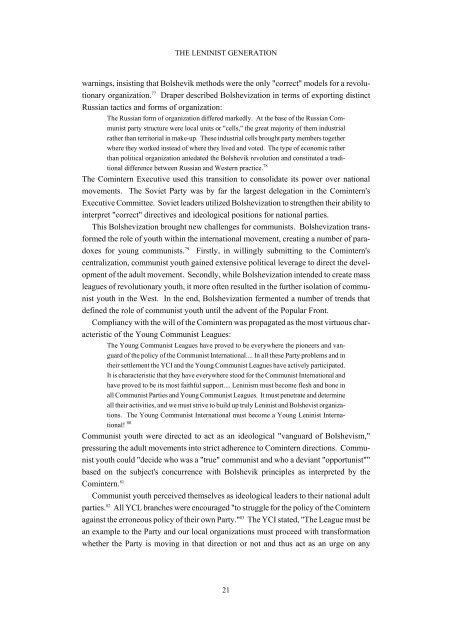Joel A Lewis Youth Against Fascism.pdf
Joel A Lewis Youth Against Fascism.pdf
Joel A Lewis Youth Against Fascism.pdf
Create successful ePaper yourself
Turn your PDF publications into a flip-book with our unique Google optimized e-Paper software.
THE LENINIST GENERATION<br />
warnings, insisting that Bolshevik methods were the only "correct" models for a revolutionary<br />
organization. 77 Draper described Bolshevization in terms of exporting distinct<br />
Russian tactics and forms of organization:<br />
The Russian form of organization differed markedly. At the base of the Russian Communist<br />
party structure were local units or "cells," the great majority of them industrial<br />
rather than territorial in make-up. These industrial cells brought party members together<br />
where they worked instead of where they lived and voted. The type of economic rather<br />
than political organization antedated the Bolshevik revolution and constituted a traditional<br />
difference between Russian and Western practice. 78<br />
The Comintern Executive used this transition to consolidate its power over national<br />
movements. The Soviet Party was by far the largest delegation in the Comintern's<br />
Executive Committee. Soviet leaders utilized Bolshevization to strengthen their ability to<br />
interpret "correct" directives and ideological positions for national parties.<br />
This Bolshevization brought new challenges for communists. Bolshevization transformed<br />
the role of youth within the international movement, creating a number of paradoxes<br />
for young communists. 79 Firstly, in willingly submitting to the Comintern's<br />
centralization, communist youth gained extensive political leverage to direct the development<br />
of the adult movement. Secondly, while Bolshevization intended to create mass<br />
leagues of revolutionary youth, it more often resulted in the further isolation of communist<br />
youth in the West. In the end, Bolshevization fermented a number of trends that<br />
defined the role of communist youth until the advent of the Popular Front.<br />
Compliancy with the will of the Comintern was propagated as the most virtuous characteristic<br />
of the Young Communist Leagues:<br />
The Young Communist Leagues have proved to be everywhere the pioneers and vanguard<br />
of the policy of the Communist International.... In all these Party problems and in<br />
their settlement the YCI and the Young Communist Leagues have actively participated.<br />
It is characteristic that they have everywhere stood for the Communist International and<br />
have proved to be its most faithful support.... Leninism must become flesh and bone in<br />
all Communist Parties and Young Communist Leagues. It must penetrate and determine<br />
all their activities, and we must strive to build up truly Leninist and Bolshevist organizations.<br />
The Young Communist International must become a Young Leninist International!<br />
80<br />
Communist youth were directed to act as an ideological "vanguard of Bolshevism,"<br />
pressuring the adult movements into strict adherence to Comintern directions. Communist<br />
youth could "decide who was a "true" communist and who a deviant "opportunist""<br />
based on the subject's concurrence with Bolshevik principles as interpreted by the<br />
Comintern. 81<br />
Communist youth perceived themselves as ideological leaders to their national adult<br />
parties. 82 All YCL branches were encouraged "to struggle for the policy of the Comintern<br />
against the erroneous policy of their own Party." 83 The YCI stated, "The League must be<br />
an example to the Party and our local organizations must proceed with transformation<br />
whether the Party is moving in that direction or not and thus act as an urge on any<br />
21

















